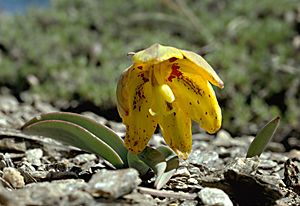Siskiyou fritillary facts for kids
Quick facts for kids Siskiyou fritillary |
|
|---|---|
 |
|
| Scientific classification | |
| Kingdom: | |
| (unranked): | |
| (unranked): | |
| Order: | |
| Family: | |
| Genus: |
Fritillaria
|
| Species: |
F. glauca
|
| Binomial name | |
| Fritillaria glauca Greene
|
|
The Fritillaria glauca is a special kind of plant often called the Siskiyou fritillary or Siskiyou missionbells. It's a type of fritillary, which is a group of beautiful flowering plants.
This plant grows naturally in northern California and southern Oregon. You can find it in rocky, mountainous areas. It especially likes a unique type of soil called serpentine. This soil is found on mountain slopes, often mixed with loose rocks and pebbles, which is known as scree or talus.
What Does the Siskiyou Fritillary Look Like?
This wildflower is not very common, making it quite special. It grows a short stem, usually between 5 to 20 centimeters tall. That's about the length of a pencil!
Around the stem, it has two to four thick leaves. These leaves are shaped a bit like a sickle, which is a curved tool. Sometimes, the stem might look a little bent or curled. This often happens because the plant grows in windy, exposed mountain spots.
The Unique Flowers and Fruits
The flower of the Siskiyou fritillary hangs downwards, like it's nodding. It's a type of lily flower. It has six thick parts called tepals. Tepals are like petals and sepals all in one. Each tepal is about one to two centimeters long.
The flowers can be yellow or purple, and they often have many spots or patterns, which is called being "densely mottled." After the flower blooms, it produces fruits. These fruits have special "wings" on them.

